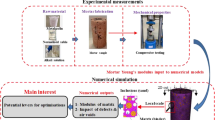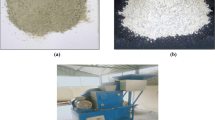Abstract
The re-utilization of construction and demolition wastes (CDWs) in the emerging geopolymer technology has been recognized as an environmentally friendly solution for tackling the ecological challenges caused by the increased landfilling of CDWs and sustainability issues of Portland Cement (PC) production. Geopolymers are synthesized as a result of intricate chemical interactions between aluminosilicate-based precursors and highly alkaline solutions resulting in the production of amorphous inorganic geopolymers possessing three-dimensional cross-linked networks of Si–O–Al and Si–O–Si bonds. The aim of this study is to investigate the effect of incorporating different types of aggregates including recycled concrete aggregates sand (RAS), silica sand (SS) and natural sand (NS) on the rheological properties of geopolymer mortars (GPM) prepared from CDW-materials comprising a combined powder mixture of recycled clay brick (RCB), recycled ceramic tile (RCT) and recycled concrete (RCW) wastes as silico-aluminate binders. Yield stress, viscosity and shear stress were tested at 100% of RAS, SS and NS contents in GPMs prepared with sodium silicate and sodium hydroxide solutions as alkaline reagents and predefined chemical design factors of SiO2/Al2O3, Na2O/SiO2, H2O/Na2O and water-to-binder (W/B) ratios. The correlation between the rheological properties of GPMs and the predefined design parameters was considered. The highest yield stress and viscosity were obtained at medium SiO2/Al2O3 molar ratio of 5.6 for all three GPM systems, while further increase in silicate species caused reduced stresses and viscosities. Comparable shear thinning behavior, higher viscosity and accelerated polycondensation properties were observed with increased RAS amounts compared to SS and NS.
Access this chapter
Tax calculation will be finalised at checkout
Purchases are for personal use only
Similar content being viewed by others
References
ASTM C188-17 (2020) Standard test method for density of hydraulic cement. pp 2–4. https://doi.org/10.1520/C0188-17.2
ASTM C33 (2018) Standard specification for concrete aggregates. ASTM Standards i (C), pp 1–8. https://doi.org/10.1520/C0033
Coelho A, de Brito J (2013) Preparation of concrete aggregates from construction and demolition waste (CDW). https://doi.org/10.1533/9780857096906.2.210
Dadsetan S, Siad H, Lachemi M, Mahmoodi O, Sahmaran M (2019) The effect of chemical factors and glass powder on the rheological properties of metakaolin based geopolymer pastes. In: CSCE annual conference, pp 1–11
Dadsetan S, Siad H, Lachemi M, Mahmoodi O, Sahmaran M (2022) Optimization and characterisation of geopolymer binders from ceramic waste, glass waste and sodium glass liquid. J Clean Prod 342(July 2021):130931. https://doi.org/10.1016/j.jclepro.2022.130931
Dadsetan S, Siad H, Lachemi M, Sahmaran M (2021) Extensive evaluation on the effect of glass powder on the rheology, strength, and microstructure of metakaolin-based geopolymer binders. Constr Build Mater 268:121168. https://doi.org/10.1016/j.conbuildmat.2020.121168
Davidovits J (1994) Geopolymers: man-made rock geosynthesis and the resulting development of very early high strength cement. Mater Educ 16(2–3):1–25
Fang G, Ho WK, Tu W, Zhang M (2018) Workability and mechanical properties of alkali-activated fly ash-slag concrete cured at ambient temperature. Constr Build Mater 172:476–87. https://doi.org/10.1016/j.conbuildmat.2018.04.008
Favier A, Hot J, Habert G, Roussel N, Lacaillerie JBDD (2014) Flow properties of MK-based geopolymer pastes. a comparative study with standard Portland cement pastes. Soft Matter 10(8):1134–1141. https://doi.org/10.1039/c3sm51889b
Han D, Yoon JY, Kim JH (2019) Control of viscosity of cementitious materials using waste limestone powder. Int J Concr Struct Mater 13(1). https://doi.org/10.1186/s40069-018-0325-9
Lahoti M, Narang P, Tan KH, Yang E-H (2017) Mix design factors and strength prediction of metakaolin-based geopolymer. Ceram Int 43:11433–11441. https://doi.org/10.1016/j.ceramint.2017.06.006
Mahmoodi O, Siad H, Lachemi M, Dadsetan S, Sahmaran M (2020) Development of ceramic tile waste geopolymer binders based on pre-targeted chemical ratios and ambient curing. Constr Build Mater 258:120297. https://doi.org/10.1016/j.conbuildmat.2020.120297
Mahmoodi O, Siad H, Lachemi M, Dadsetan S, Sahmaran M (2020) Optimization of brick waste-based geopolymer binders at ambient temperature and pre-targeted chemical parameters. J Clean Prod 268:122285. https://doi.org/10.1016/j.jclepro.2020.122285
Mahmoodi O, Siad H, Lachemi M, Dadsetan S, Sahmaran M (2020) Development of normal and very high strength geopolymer binders based on concrete waste at ambient environment. J Clean Prod 279(January):123436. https://doi.org/10.1016/j.jclepro.2020.123436
Mahmoodi O, Siad H, Lachemi M, Dadsetan S, Sahmaran M (2021) Development and characterization of binary recycled ceramic tile and brick wastes-based geopolymers at ambient and high temperatures. Constr Build Mater 301(February):124138. https://doi.org/10.1016/j.conbuildmat.2021.124138
Mahmoodi O, Siad H, Lachemi M, Dadsetan S, Şahmaran M (2022) Optimized application of ternary brick, ceramic and concrete wastes in sustainable high strength geopolymers. J Clean Prod 338:130650. https://doi.org/10.1016/j.jclepro.2022.130650
Mesgari S, Akbarnezhad A, **ao JZ (2020) Recycled geopolymer aggregates as coarse aggregates for Portland cement concrete and geopolymer concrete: effects on mechanical properties. Constr Build Mater 236:117571. https://doi.org/10.1016/j.conbuildmat.2019.117571
Mitschka P (1982) Simple conversion of brookfield R.V.T. readings into viscosity functions. 209:207–209
Ren X, Zhang L (2019) Experimental study of geopolymer concrete produced from waste concrete. J Mater Civ Eng 31(7):1–14. https://doi.org/10.1061/(ASCE)MT.1943-5533.0002750
Robalo K, Costa H, Júlio E (2021) Experimental development of low cement content and recycled construction and demolition waste aggregates concrete. Constr Build Mater 273:121680. https://doi.org/10.1016/j.conbuildmat.2020.121680
Robayo-Salazar RA, Mejía-Arcila JM, de Gutiérrez RM (2017) Eco-efficient alkali-activated cement based on red clay brick wastes suitable for the manufacturing of building materials. J Clean Prod 166:242–52. https://doi.org/10.1016/j.jclepro.2017.07.243
Shaikh FUA (2016) Mechanical and durability properties of fly ash geopolymer concrete containing recycled coarse aggregates. Int J Sustain Built Environ 5(2):277–287. https://doi.org/10.1016/j.ijsbe.2016.05.009
Sitarz M, Urban M, Hager I (2020) Rheology and mechanical properties of fly ash-based geopolymer mortars with ground granulated blast furnace slag addition. Energies 13(10). https://doi.org/10.3390/en13102639
Soultana A, Valouma A, Bartzas G, Komnitsas K (2019) Properties of inorganic polymers produced from brick waste and metallurgical slag. Minerals 9(9):1–17. https://doi.org/10.3390/min9090551
Turkyilmaz A, Guney M, Karaca F, Bagdatkyzy Z, Sandybayeva A, Sirenova G (2019) A comprehensive construction and demolition waste management model using PESTEL and 3R for construction companies operating in Central Asia. Sustainability (Switz) 11(6). https://doi.org/10.3390/su11061593
Environment UN, Scrivener KL, John VM, Gartner EM (2018) Eco-efficient cements: potential economically viable solutions for a low-CO2 cement-based materials industry. Cem Concr Res 114(June):2–26. https://doi.org/10.1016/j.cemconres.2018.03.015
Yaseri S, Hajiaghaei G, Mohammadi F, Mahdikhani M, Farokhzad R (2017) The role of synthesis parameters on the workability, setting and strength properties of binary binder based geopolymer paste. Constr Build Mater 157:534–545. https://doi.org/10.1016/j.conbuildmat.2017.09.102
Yeheyis M, Kasun M, Alam S, Eskicioglu C, Sadiq R (2013) An overview of construction and demolition waste management in Canada: a lifecycle analysis approach to sustainability. Clean Technol Environ Policy 15(1):81–91. https://doi.org/10.1007/s10098-012-0481-6
Author information
Authors and Affiliations
Corresponding author
Editor information
Editors and Affiliations
Rights and permissions
Copyright information
© 2024 Canadian Society for Civil Engineering
About this paper
Cite this paper
Mahmoodi, O., Siad, H., Lachemi, M., Dadsetan, S., Sahmaran, M. (2024). Rheological Properties of Geopolymer Mortars Incorporating Construction and Demolition Wastes-Based Binders and Aggregates. In: Gupta, R., et al. Proceedings of the Canadian Society of Civil Engineering Annual Conference 2022. CSCE 2022. Lecture Notes in Civil Engineering, vol 359. Springer, Cham. https://doi.org/10.1007/978-3-031-34027-7_53
Download citation
DOI: https://doi.org/10.1007/978-3-031-34027-7_53
Published:
Publisher Name: Springer, Cham
Print ISBN: 978-3-031-34026-0
Online ISBN: 978-3-031-34027-7
eBook Packages: EngineeringEngineering (R0)




